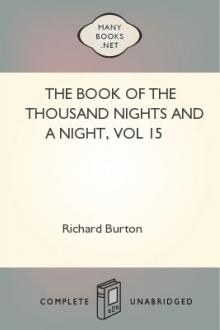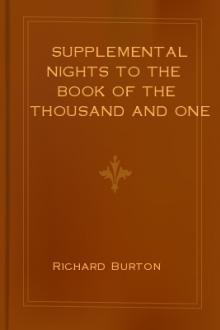The Book of the Thousand Nights and a Night, vol 15 by Sir Richard Francis Burton (classic romance novels .TXT) 📖

- Author: Sir Richard Francis Burton
- Performer: -
Book online «The Book of the Thousand Nights and a Night, vol 15 by Sir Richard Francis Burton (classic romance novels .TXT) 📖». Author Sir Richard Francis Burton
[FN#23] In text “Fid�wi,” see “Fid�‘i” and “Fidaw�yah,” suppl.
col. iv. 220.
[FN#24] [In the text “Al-K�z�nat,” pl. of “K�z�n,” which occurs in Spitta Bey’s tales under the form “Kaz�n” on account of the accent. It is the Turkish “Kazgh�n,” vulgarly pronounced “Kazan,”
and takes in Persian generally the form “Kazk�n.” In Night 652 it will be met again in the sense of crucibles.—ST.]
[FN#25] In text “Banj al-tayy�r,” i.e. volatile: as we should say, that which flies fastest to the brain.
[FN#26] This marvellous bird, the “Ter-il-bas” (Tayr T��s?), is a particular kind of peacock which is introduced with a monstrous amount of nonsense about “Dagon and his son Bil-il-Sanan” and made to determine elections by alighting upon the head of one of the candidates in Chavis and Cazotte, “History of Yamalladdin (Jam�l al-Din), Prince of Great Katay” (Kh�t� = Cathay = China).
See Heron, iv. 159.
[FN#27] Lit. “hath given it to him.”
[FN#28] Arab. “Jih�z,” the Egypt. “Gah�z,” which is the Scotch “tocher,” and must not be confounded with the “Mahr” = dowry, settled by the husband upon the wife. Usually it consists of sundry articles of dress and ornament, furniture (matting and bedding carpets, divans, cushions and kitchen utensils), to which the Badawi add “Gribahs” (water-skins) querns, and pestles with mortars. These are usually carried by camels from the bride’s house to the bridegroom’s: they are the wife’s property, and if divorced she takes them away with her and the husband has no control over the married woman’s capital, interest or gains. For other details see Lane M.E. chapt. vi. and Herklots chapt. xiv.
sec. 7.
[FN#29] [Arab. “Shuw�r” = trousseau, whence the verb “shawwara binta-hu” = he gave a marriage outfit to his daughter. See Dozy Suppl. s. v. and Arnold Chrestom. 157, 1. —ST.]
[FN#30] Arab. “Ghash�m,” see vol. ii. 330. It is a favourite word in Egypt extending to Badawiland, and especially in Cairo, where it is looked upon as slighting if not insulting.
[FN#31] The whole of the scene is a replica of the marriage between Kamar al-Zam�n and that notable blackguard the Lady Bud�r (vol. iii. 211), where also we find the pigeon slaughtered (p.
289). I have mentioned that the blood of this bird is supposed throughout the East, where the use of the microscope is unknown, and the corpuscles are never studied, most to resemble the results of a bursten hymen, and that it is the most used to deceive the expert eyes of midwives and old matrons. See note to vol. iii. p. 289.
[FN#32] Scott (p. 254) makes his heroine “erect a most magnificent caravanserai, furnished with baths hot and cold, and every convenience for the weary traveller.” Compare this device with the public and royal banquet (p. 212) contrived by the slave-girl sultaness, the charming Zumurrud or Smaragdine in the tale of Ali Sh�r, vol. iv. 187.
[FN#33] In text “Shakhs,” see vol. iii. 26; viii. 159.
[FN#34] This assemblage of the dramatis person� at the end of the scene, highly artistic and equally improbably, reminds us of the ending of King Omar bin al-Nu’uman (vol. iii. 112) [FN#35] The King and the Minister could not have recognised the portrait as neither had seen the original.
[FN#36] In text “Ishtalaka” = he surmised, discovered (a secret).
[FN#37] In the Arab. “she knew them,” but the careless storyteller forgets the first part of his own story.
[FN#38] Storytelling being servile work.
[FN#39] [In the MS. “istanat� l�-ha.” The translation in the text presupposes the reading “istanatt�” as the 10th form of “matt) =
he jumped, he leapt. I am inclined to take it for the 8th form of “sanat,” which according to Dozy stands in its 2nd form “sannat”
for “sannat,” a transposition of the classical “nassat” = he listened to. The same word with the same meaning of “listening attentively,” recurs in the next line in the singular, applying to the captain and the following pronoun “la-h�” refers in both passages to “Hik�yah,” tale, not to the lady-sultan who reveals herself only later, when she has concluded her narrative.—ST.]
[FN#40] Here the converse is probably meant, as we have before seen.
[FN#41] Scott ends (p. 258) “Years of unusual happiness passed over the heads of the fortunate adventurers of this history, until death, the destroyer of all things, conducted them to a grave which must one day be the resting-place for ages of us all, till the receiving (?) angel shall sound his trumpet.”
[FN#42] Scott (vi. 259-267), “Story of Hyjuaje, the tyrannical Governor of Coufeh, and the Young Syed.” For the difference between the “Sayyid” (descendant of Hasan) and the “Shar�f,”
derived from Husayn, see vol. v. 259. Being of the Holy House the youth can truly deny tat he belongs to any place or race, as will be seen in the sequel.
[FN#43] This masterful administrator of the Caliphate under the early Ommiades is noticed in vols. iv. 3, vii. 97. The succession to the Prophet began—as mostly happens in the proceedings of elective governments, republics, and so forth—with the choice of a nobody, “Abubakr the Veridical,” a Meccan merchant, whose chief claim was the glamour of the Apostolate. A more notable personage, and seen under the same artificial light, was “Omar the Justiciary,” also a trader of Meccah, who was murdered for an act of injustice. In Osman nepotism and corruption so prevailed, while distance began to dim the Apostolic glories, that the blood-thirsty turbulence of the Arab was aroused and caused the death of the third Caliph by what we should call in modern phrase “lynching.” Ali succeeded, if indeed we can say he succeeded at all, to an already divided empire. He was only one of the four who could be described as a man of genius, and therefore he had a host of enemies: he was a poet, a sage, a moralist and even a grammarian; brave as a lion, strong as a bull, a successful and experienced captain, yet a complete failure as a King. A mere child in mundane matters, he ever acted in a worldly sense as he should have avoided acting, and hence, after a short and disastrous reign, he also was killed. His two sons, Hasan and Husayn, inherited all the defects and few of the merits of their sire: Hasan was a pauvre diable, whose chief characteristic was addiction to marriage, and by poetical justice one of his wives murdered him. Husayn was of stronger mould, but he fought against the impossible; for his rival was Mu’�wiyah, the Cavour of the Age, the longest-headed man in Arabia, and against Yaz�d, who, like Italy of the present day, flourished and prospered by the artificial game which the far-seeing politician, his father, had bequeathed to his house—the Ommiade. The fourth of this dynasty, �Abd al-Malik bin Marw�n, “the Father of Flies,” and his successor, Al-Walid, were happy in being served thoroughly and unscrupulously by Al-Hajj�j, the ablest of Lieutenants. whose specialty it was to take in hand a revolted province, such as Al-Hij�z, Al-Ir�k, or Khor�s�n, and to slaughter it into submission; besides deaths in battle he is computed to have slain 120,000 men. He was an unflinching preacher of the Divine Right of Kings and would observe that the Lord says, “Obey Allah and ye can” (conditional), but as regards royal government “Hearing and obeying” (absolute); ergo, all opposition was to be cut down and uprooted. However, despite his most brilliant qualities, his learning, his high and knightly sense of honour, his insight and his foresight (e.g. in building W�sit), he won an immortality of infamy: he was hated by his contemporaries, he is the subject of silly tale and offensive legend (e.g., that he was born without anus, which required opening with instruments, and he was suckled by Satan’s orders on blood), and he is still execrated as the tyrant, per excellentiam, and the oppressor of the Holy Family—
the children and grand-children of the Apostle.
The traditional hatred of Al-Hajjaj was envenomed by the accession of the Abbasides and this dynasty, the better to distinguish itself from the Ommiades, affected love for the Holy Family, especially Ali and his descendants, and a fanatical hatred against their oppressors. The following table from Ibn Khald�n (Introduct. xxii.) shows that the Caliphs were cousins, which may account for their venomous family feud.
[First Version]
‘Abd Manaf
|
____________|____________
| |
Hashim Abd Shams | |
Abd al-Muttalib Umayyah | |
___________|__________ ____|______
| | | | |
Al-Abbas Abdullah Abu Talib Harb Abu ‘l-Aus | | | | |
Abdullah Mohammed | Abu Sufyan Al-Hakim | | | | |
Ali Fatimah married Ali Mu’awiyah Marwan | _____|_____ (1st Ommiade) | | |
Mohammed Al-Hasan Al-Husayn
|
Al-Saff�h
(1st Abbaside)
[Second Version]
‘Abd Manaf, father of Hashim and Abd Shams Hashim, father of Abd al-Muttalib
Abd al-Muttalib, father of Al-Abbas, Abdullah, and Abu Talib Al-Abbas, father of Abdullah
Abdullah, father of Ali
Ali, father of Mohammed
Mohammed, father of Al-Saff�h (1st Abbaside) Abdullah, father of Mohammed
Mohammed, father of Fatimah, who married Ali (son of Abu Talib) Fatimah, mother of Al-Hasan and Al-Husayn Abu Talib, father of Ali
Abd Shams, father of Umayyah
Umayyah, father of Harb and Abu ‘l-Aus Harb, father of Abu Sufyan
Abu Sufyan, father of Mu’awiyah (1st Ommaide) Abu ‘l-Aus, father of Al-Hakim
Al-Hakim, father of Marwan
[FN#44] [The word here translated “invited guest” reads in the MS. “Mad’�r.” In this form it is no dictionary word, but under the root “D’r” I find in the Muh�t: “wa ‘l-‘�matu tak�lu ful�nun da’irun ya’n� ghal�zun j�fin” = the common people say such a one is “daiir,” i.e., rude, churlish. “Mad’�r” may be a synonym and rendered accordingly: as though thou wert a boor or clown.—ST]
[FN#45] A neat specimen of the figure anachronism. Al-Hajjaj died in A.H. 95 (= AD 714), and Cairo was built in A.H. 358 (= AD
968).
[FN#46] Perfectly true in the present day. The city was famed for intelligence and sanguinary fanaticism; and no stranger in disguise could pass through it without detection. This ended with the massacre of 1840, which brought a new era into the Moslem East. The men are, as a rule, fine-looking, but they seem to be all show: we had a corps of them in the old B�sh-Buzuks, who, after a month or two in camp, seemed to have passed suddenly from youth into old age.
[FN#47] In text, “Yasta’amil�na al-Mrd,” which may have a number of meanings, e.g. “work frowardness” (Maradd), or “work the fruit of the tree Ar�k” (Maradd = wild capparis) and so forth. I have chosen the word mainly because “Murd” rhymes to “Burd.” The people of Al-Yaman are still deep in the Sotadic Zone and practice; this they owe partly to a long colonization of the “‘Ajam,” or Persians. See my Terminal Essay, � “Pederasty,” p.
178.
[FN#48] “Burd,” plur. of “Burdah” = mantle or woolen plaid of striped stuff: vol. vii. 95. They are still woven in Arabia, but they are mostly white.
[FN#49] So in Tabari (vol. III. 127) Al Hajj�j sees a man of haughty mien (Abd al-Rahm�n bin Abdullah), and exclaims, “Regarde comme il est orgueilleux: par Dieu, j’aurais envie de lui couper la t�te!”
[FN#50] [The phrase is Koranic (viii. 24): “Wa ‘lam� anna ‘ll�ha yah�lu bayna ‘l-mari wa kalbi-hi,” which Rodwell translates: Know that God cometh in between man and his own heart.—ST]
[FN#51] “Yathrib,” the classical name �{Greek}, one of the multifarious titles of what is called in





Comments (0)